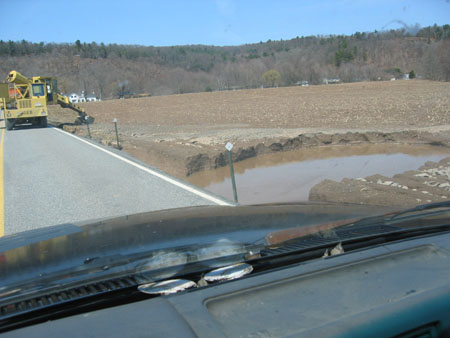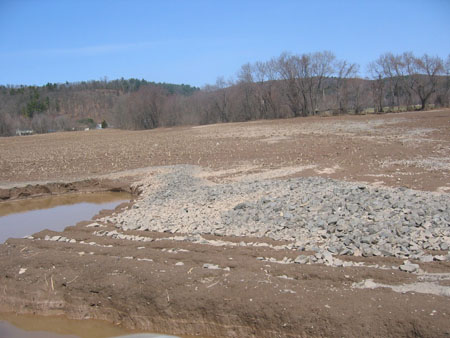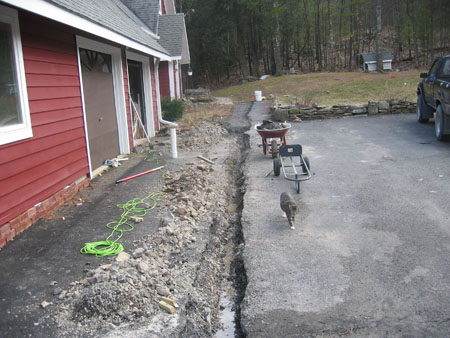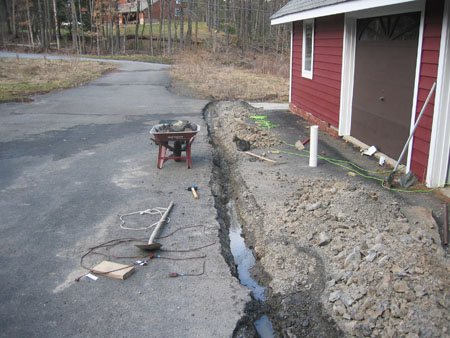|
|
|
rockbreaking skill
Tuesday, April 5 2005
I got out of bed at about 9am this morning, which was early given the fact that I've yet to acclimate to Daylight Savings Time. But I needed to be up at a reasonable time so I could get more use out of the jackhammer before having to return it at noon. I ended up running it for a good two hours, which guaranteed soreness and stiffness throughout my body for many hours to come. The victims of its relentless hopping consisted entirely of rock ledges exposed by the removal of soil in the driveway ditch.
When I went to return the jackhammer, I tried again to get across the Esopus on Wynkoop Road and this time nobody with a faint mustache was standing there to tell me I couldn't. Instead there was a flag man signalling me to wait while dump trucks and various scooping machinery cleaned up the mess. Knowing I would eventually get through, I was perfectly happy to wait.
Most of the damage was concentrated in the patch of suburbia just west of the bridge. Evidently this bit of former cornfield is set somewhat lower than its sister patch of suburbia (which is closer to Hurley Mountain Road). Here the houses had visible damage, with broken gutters, ruined swimming pools, and driftwood washed up roughly against porches. But the most remarkable damage was to the lawns, many of which had been stripped of sod or covered with mud and debris. Soil directly downstream from the Wynkoop Roadway (both lawn and corn field) had suffered the worst, due to the strong waterfall-like currents of water cascading down off the asphalt. There was one place at the edge of the corn field featuring a spectacular new hole twenty feet wide and four or five feet deep. There was a windrow of fist-sized cobblestones beyond this line of damage, perhaps a last-ditch attempt by humanity to save the field from ruin. This had apparently worked, because there was little or no damage beyond those cobbles.
As for the picturesque iron bridge connecting Hurley's farmland to its downtown, it seemed to be in good shape as I crossed it. The natural levees of the Esopus are rather high at this bridge and its possible the bridge itself hadn't actually been inundated. And there was no sign of water damage at the Hurley Mountain Inn, which lies just beyond the bridge.
I spent the rest of the day with a four pound sledge hammer and a inch and a half wide cold chisel removing "high spots" and "narrow spots" from the driveway ditch. It might surprise you to learn that breaking big rocks into smaller ones is a real skill and one can improve at it with practice. After a few hours I could glance at rock and know intuitively where its weakest spot was. That's where I'd put the edge of the chisel. Then I'd spank the other end with the hammer. Bang! Bang! Dank! I could tell from the noise it was making whether there was any chance of it breaking. If the sound had a metallic ring I'd know it was a lost cause or would require massive blows. But if it made more of a thud then I knew it would all be over soon.
Breaking rock is a very different process from removing it. When you're using a hammer and a chisel, the force is so concentrated that it's not always obvious when it's time to switch from destroying to cleaning up. Sometimes when the rock would crack (often invisibly) I'd keep beating it and nothing much would be happening. But then I'd go to pick at it with my fingers and it would be like lifting Brazil nuts out of a bowl. I also noticed that when the rock was sufficiently weak it was easiest just to go at it with the mattock, which cuts such an indiscriminate swath that there's no trouble distinguishing what continues to fight from what has already surrendered.
This evening Gretchen and I watched the gran final of Mujer de Madera, the Spanish language soap opera (set in Mexico) that we've been watching for most of the past year. It had been recorded by our Tivo on April first, but we were running a few days behind.
The way it ended gave the impression that this wasn't just the end of the season but the end of the show forever, which made sense given the meager plot possibilities remaining at the end of the long and crazy story arc. Since most of the energy for the subplots was provided by the tension of unfulfilled romantic desire, nobody throughout the series was shown in a happy marriage (except one couple for several weeks preceding the murder of one of them). In the penultimate show, though, a combo three-couple marriage finally places most of the main characters in happy matrimony.
In today's final episode those characters are forced to confront the one villain still not imprisoned. Then, once that mess is cleaned up, the show comes unmoored from its unwritten guidelines. About fifteen minutes from the end the show's three most photogenic couples face the camera PSA-style, lecturing us about the danger of environmental destruction and global warming. Then, not quite as oddly, the time frame fast forwards a year into the future for a brief scene in one of the couple's happily ever after. This really was the future too, since up until that point the show had been presented as contemporary with real time.

A massive hole just north of Wynkoop Road in the Esopus Valley. That machine appears to be gathering cobblestones placed to protect the field from erosion like this.
Note the freshwater clamshells on my dashboard.

The cobblestone erosion control.

Julius strides beside the driveway ditch this afternoon. We're viewing it from the north. Note
all the broken rocks removed so far.

The ditch, viewed from the south. I ran water into it to locate high spots.
For linking purposes this article's URL is:
http://asecular.com/blog.php?050405 feedback
previous | next |



